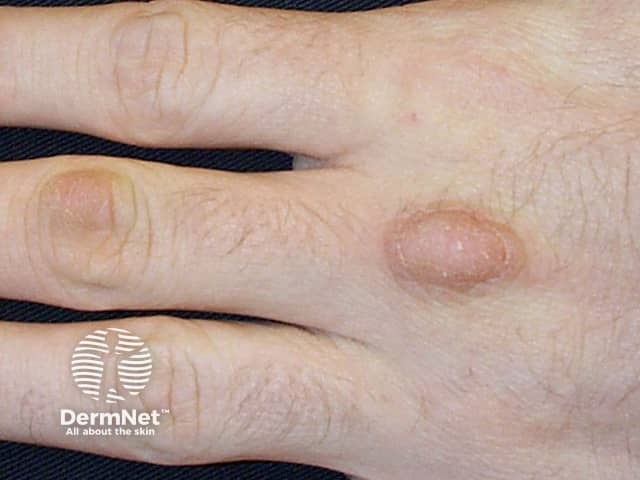Main menu
Common skin conditions

NEWS
Join DermNet PRO
Read more
Quick links
Knuckle pad — extra information
Introduction
Demographics
Clinical features
Diagnosis
Treatment
What is a knuckle pad?
A knuckle pad is a well-defined thickening over a finger joint. They are also called Garrod pads or holoderma. Knuckle pads are classified as a form of fibromatosis along with Dupuytren contracture (palmar fibromatosis), pachydermodactyly, Ledderhose syndrome (plantar fibromatosis) and Peyronie disease (penile fibromatosis).

Knuckle pads

Knuckle pads

Knuckle pads
Who gets knuckle pads and why?
Knuckle pads can develop as part of an inherited syndrome, may run in families together with other forms of fibromatosis, or as a sporadic occurrence.
Examples of genetic syndromes that include knuckle pads as a feature are:
- Epidermolytic palmoplantar keratoderma (MIM 1144200)
- Bart-Pumphrey syndrome (MIM 149200)
- Acrokeratoelastoidosis of Costa (MIM 101850)
- Camptodactyly (MIM 114200).
There is some debate as to whether true knuckle pads are a response to trauma (calluses). These are more likely to be callosities developing from repetitive pressure or friction, for example, occupational, sporting, finger sucking/chewing, or bulimia nervosa.
Some also attempt to distinguish ‘Dupuytren nodules’ and ‘dorsal cutaneous pads’, the former occurring only in patients with Dupuytren contracture and the latter occurring in both control and Dupuytren contracture populations.
Knuckle pads most commonly become apparent after the age of 30 years. Where there is a family history of knuckle pads, they usually appear at about the same age within a family. But the age of onset varies between families. In children, there is usually no apparent cause.
What are the clinical features of a knuckle pad?
A knuckle pad is more often located over a proximal interphalangeal (second) joint than over a knuckle (metacarpophalangeal/first joint) or distal interphalangeal (third) joint.
The pad may be seen over just one joint or many. The hands are most commonly affected but other joints, such as the feet and knees, may be involved.
Knuckle pads are well-defined, smooth, firm thickenings that can be flat or more obvious and dome-shaped. They generally do not cause any symptoms but can be tender or painful.
How are knuckle pads diagnosed?
Usually, knuckle pads are diagnosed clinically. However, there are several other conditions that may cause confusion including granuloma annulare, pachydermodactyly, rheumatoid nodules, and synovitis resulting in swollen joints.
Ultrasound can be useful for distinguishing knuckle pads from synovitis.
Should a skin biopsy be performed, histology shows hyperkeratosis and acanthosis of the epidermis and thickening of the dermis and individual collagen fibres. When associated with a keratin 9 gene mutation, as in epidermolytic palmoplantar keratoderma, suprabasal epidermolysis is also seen.
What is the treatment for a knuckle pad?
In general, treatment is not required for a knuckle pad. Avoidance of repetitive behaviour if possible may improve the situation. Moisturisers may be useful if the knuckle pads are hyperkeratotic. Surgery has been used, but can be complicated by the development of keloid scars.
References
- Balighi K, Moeineddin F, Lajevardi V, Ahmadreza R. A family with leukonychia totalis. Indian J Dermatol. 2010;55(1):102–4. DOI: 10.4103/0019-5154.60365. PMID: 20418990; PMCID: PMC2856358.
- Codispoti A, Colombo E, Zocchi L, Serra V, et al. Knuckle pads, in an epidermal palmoplantar keratoderma patient with Keratin 9 R163W transgradiens expression. Eur J Dermatol. 2009 Mar-Apr;19(2):114–8. DOI: 10.1684/ejd.2008.0575. Epub 2008 Dec 23. PMID: 19106041.
- Lopez-Ben R, Dehghanpisheh K, Chatham WW, Lee DH, Oakes J, Alarcón GS. Ultrasound appearance of knuckle pads. Skeletal Radiol. 2006 Nov;35(11):823–7. DOI: 10.1007/s00256-006-0110-8. Epub 2006 May 11. PMID: 16688449.
- Malik S, Schott J, Schiller J, Junge A, Baum E, Koch MC. Fifth finger camptodactyly maps to chromosome 3q11.2-q13.12 in a large German kindred. Eur J Hum Genet. 2008 Feb;16(2):265–9. DOI: 10.1038/sj.ejhg.5201957. Epub 2007 Nov 14. PMID: 18000522.
- Nemoto-Hasebe I, Akiyama M, Kudo S, Ishiko A, Tanaka A, Arita K, Shimizu H. Novel mutation p.Gly59Arg in GJB6 encoding connexin 30 underlies palmoplantar keratoderma with pseudoainhum, knuckle pads and hearing loss. Br J Dermatol. 2009 Aug;161(2):452–5. DOI: 10.1111/j.1365-2133.2009.09137.x. Epub 2009 Mar 30. PMID: 19416251.
- Nenoff P, Woitek G. Images in clinical medicine. Knuckle pads. N Engl J Med. 2011 Jun 23;364(25):2451. DOI: 10.1056/NEJMicm1008915. PMID: 21696311.
- Rayan GM, Ali M, Orozco J. Dorsal pads versus nodules in the normal population and Dupuytren's disease patients. J Hand Surg Am. 2010 Oct;35(10):1571–9. DOI: 10.1016/j.jhsa.2010.06.001. PMID: 20800974.
- Rook's Textbook of Dermatology
On DermNet
Other websites
- Knuckle Pads — Medscape Reference
